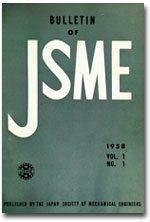Volume 5, Issue 19
Displaying 1-23 of 23 articles from this issue
- |<
- <
- 1
- >
- >|
-
1962 Volume 5 Issue 19 Pages 389-394
Published: 1962
Released on J-STAGE: February 15, 2008
Download PDF (564K) -
1962 Volume 5 Issue 19 Pages 394-401
Published: 1962
Released on J-STAGE: February 15, 2008
Download PDF (789K) -
1962 Volume 5 Issue 19 Pages 402-411
Published: 1962
Released on J-STAGE: February 15, 2008
Download PDF (902K) -
1962 Volume 5 Issue 19 Pages 412-421
Published: 1962
Released on J-STAGE: February 15, 2008
Download PDF (1634K) -
1962 Volume 5 Issue 19 Pages 422-428
Published: 1962
Released on J-STAGE: February 15, 2008
Download PDF (1004K) -
1962 Volume 5 Issue 19 Pages 429-436
Published: 1962
Released on J-STAGE: February 15, 2008
Download PDF (882K) -
1962 Volume 5 Issue 19 Pages 437-443
Published: 1962
Released on J-STAGE: February 15, 2008
Download PDF (1069K) -
1962 Volume 5 Issue 19 Pages 443-450
Published: 1962
Released on J-STAGE: February 15, 2008
Download PDF (878K) -
1962 Volume 5 Issue 19 Pages 450-460
Published: 1962
Released on J-STAGE: February 15, 2008
Download PDF (1254K) -
1962 Volume 5 Issue 19 Pages 461-470
Published: 1962
Released on J-STAGE: February 15, 2008
Download PDF (1046K) -
1962 Volume 5 Issue 19 Pages 470-478
Published: 1962
Released on J-STAGE: February 15, 2008
Download PDF (932K) -
1962 Volume 5 Issue 19 Pages 479-484
Published: 1962
Released on J-STAGE: February 15, 2008
Download PDF (604K) -
1962 Volume 5 Issue 19 Pages 485-491
Published: 1962
Released on J-STAGE: February 15, 2008
Download PDF (736K) -
1962 Volume 5 Issue 19 Pages 492-497
Published: 1962
Released on J-STAGE: February 15, 2008
Download PDF (736K) -
1962 Volume 5 Issue 19 Pages 497-504
Published: 1962
Released on J-STAGE: February 15, 2008
Download PDF (1495K) -
1962 Volume 5 Issue 19 Pages 505-510
Published: 1962
Released on J-STAGE: February 15, 2008
Download PDF (659K) -
1962 Volume 5 Issue 19 Pages 510-517
Published: 1962
Released on J-STAGE: February 15, 2008
Download PDF (892K) -
1962 Volume 5 Issue 19 Pages 517-524
Published: 1962
Released on J-STAGE: February 15, 2008
Download PDF (1064K) -
1962 Volume 5 Issue 19 Pages 525-534
Published: 1962
Released on J-STAGE: February 15, 2008
Download PDF (2041K) -
1962 Volume 5 Issue 19 Pages 535-544
Published: 1962
Released on J-STAGE: February 15, 2008
Download PDF (1269K) -
1962 Volume 5 Issue 19 Pages 545-553
Published: 1962
Released on J-STAGE: February 15, 2008
Download PDF (779K) -
1962 Volume 5 Issue 19 Pages 554-560
Published: 1962
Released on J-STAGE: February 15, 2008
Download PDF (833K) -
1962 Volume 5 Issue 19 Pages 561-570
Published: 1962
Released on J-STAGE: February 15, 2008
Download PDF (1118K)
- |<
- <
- 1
- >
- >|
